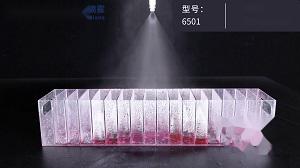How to detect nozzle problems?
Nozzle problems are minor in their initial effects and are often ignored.
With the change of the throat, the change of spray characteristics is gradually obvious, and can be monitored.
Flow rate: when using centrifugal pump, when the throat is constantly wearing, the nozzle under a certain pressure, the flow rate will usually increase.
Because this traffic increase is not easy to observe, it is recommended that traffic detection be performed periodically.
Flow detection can be done by measuring flowmeter readings or by collecting the amount of water sprayed over a given period of time with a collection method at a given pressure.
Compare these readings with those on the sample, or with new, unused nozzle readings.
When a reciprocating pump is used, the water flow rate does not change when the throat is worn, but the pressure in the liquid line decreases.
.jpg)
.jpg)
Spray shape: When the fan nozzle is damaged, blocked or bonded at the throat, the uneven change of spray shape can be easily observed.
When the throat is gradually worn, the change of spray shape is not easily observed until the flow rate increases substantially.
For applications requiring very uniform spray coverage, special equipment or tests are required to detect the uniformity of spray shapes.
The shape of fan nozzle with oval throat is blade shape with thick fan or conical edge, so the overlapping distribution of adjacent nozzles is ideal.
As the throat wears away, the Angle contained in the spray shape is observed to decrease.


More water will be found flowing in the center, increasing the distribution of water.
It can also be found that there are bars and hollows in the spray shape.
Hollow conical nozzle - basically a liquid ring, the uneven spray shape is mainly shown as a strip in some areas.
Solid conical, square or oval spray nozzles have the same inhomogeneity of spray shape as fan nozzles, with more water concentrated in the center.
The change of spray shape caused by blade clogging inside solid nozzle is irregular.
Spray pressure: Nozzle problems caused by pressure changes are difficult to detect.
With a centrifugal pump, spray pressure remains roughly constant, but fluid flow usually increases with wear at the nozzle throat.
An increase in flow will result in an increase in the cost of the liquid sprayed.
If a reciprocating pump is used for water supply, the flow rate remains constant and the jet pressure decreases with wear or corrosion of the nozzle.
Low spray pressure reduces spray impact.
If the nozzle is blocked and the injection pressure rises, it can exceed the maximum pressure allowed by the system, causing equipment damage or personal injury.


The change of spray pressure also causes the change of spray coverage area.
Particle size: With the wear or corrosion of the nozzle, the flow rate increases and the pressure decreases, resulting in larger spray particles.
This problem is usually invisible, but can be analyzed with application results.
Nozzle alignment: When multiple fan nozzles are installed in a nozzle, a complete uniform coverage is required. All nozzles are required to accurately position each other, that is, all fan spray shapes are accurately aligned to ensure accurate coverage area.
All sprays should be parallel to each other at a 5° to 10° Angle from the nozzle.
Otherwise the coverage would be uneven.


